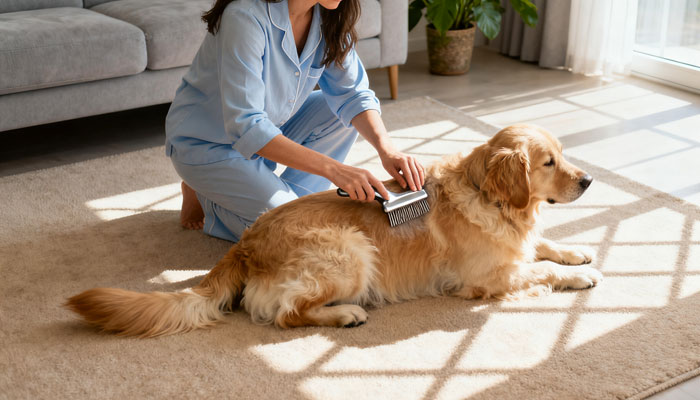Eliminate fleas on dogs using natural methods

I. Bathing to Remove Fleas on Dogs
Regularly bathing your dog with warm water and mild dish soap or dog-specific shampoo can kill most fleas on dogs. This method is effective for mild to moderate flea infestations. However, it may not be effective if the flea population is too large. Use only mild, fragrance-free and dye-free soap, selecting a type suitable for sensitive skin. If your dog shows an adverse reaction to the soap, stop immediately. After bathing, follow with a dog-specific conditioner to prevent coat dryness. Bathe your dog with soap once a week. Excessive bathing (especially with detergent) can dry and damage your dog’s skin. Soap traps fleas on dogs, dislodging them from the dog’s body. Additionally, soap disrupts the fleas’ cell membranes, stripping away their protective layer. Unable to retain moisture, fleas on dogs quickly die from dehydration.
II. Combing with a Flea Comb to Remove Fleas on Dogs
Comb your dog with a flea comb to help eliminate fleas on dogs. You can purchase a specialized flea comb or use a regular comb with very fine teeth. The flea comb directly removes fleas on dogs from the fur. Comb from top to bottom. Ensure the comb touches the dog’s skin during brushing; skipping the skin while only combing the fur will leave some fleas behind. Immediately after combing, submerge the comb in warm soapy water. The soapy water will kill any fleas on the comb.
III. Repelling Fleas on Dogs with Lemon Juice
Use diluted lemon juice to repel fleas on dogs. Apply it to the dog’s coat to kill fleas. Use lemon juice cautiously to avoid drying out the dog’s skin. Mix equal parts lemon juice and warm water in a shallow bowl. Alternatively, cut one lemon into 4 wedges and steep them in boiling water. Steep for 8 hours or overnight, then strain the lemon liquid into a bowl. Dip your dog’s brush or comb into the lemon solution before grooming. As the fur comes into contact with the brush, it will be coated with lemon juice. Be sure to thoroughly comb through the fur, re-dipping the brush into the lemon solution after each stroke to better target any fleas present. Repeat this process once daily for 3 days to more effectively address fleas on your dog.
IV. Treating Fleas on Dogs with Apple Cider Vinegar
Use apple cider vinegar to treat fleas on dogs. Apply it directly to your dog’s coat to target flea infestations. Mix equal parts apple cider vinegar and warm water in a spray bottle. Spray the solution onto your dog’s coat, focusing on areas where fleas commonly gather—such as behind the ears, the base of the tail, and the back of the legs. If your dog’s skin suddenly becomes very dry or you suspect an adverse reaction to the apple cider vinegar, discontinue this flea treatment immediately.
V. Prepare Rosemary Flea-Repellent Rinse to Combat Fleas on Dogs
Prepare a rosemary flea-repellent rinse to help alleviate fleas on your dog. While not scientifically validated, anecdotal evidence suggests this method may effectively repel fleas on dogs. Bathe your dog in rosemary-infused water and allow it to air dry. Steep 500 ml of fresh rosemary sprigs in boiling water for 30 minutes, ensuring the water fully covers the herbs. Strain the liquid and discard the stems. Add 4 liters of warm water to the rosemary infusion. Reduce the water volume for smaller dogs. Allow the rosemary water to cool slightly. Ensure it remains warm but not hot enough to scald your pet. Pour the water over the dog, thoroughly wetting it, then let it air dry naturally. This is intended to repel fleas on dogs.
admin
-
Sale!

Washable Pet Cooling Pad for Cats and Dogs
$10.99Original price was: $10.99.$9.99Current price is: $9.99. This product has multiple variants. The options may be chosen on the product page -
Sale!

Washable Cat Window Hammock Cooling Bed
$23.99Original price was: $23.99.$22.99Current price is: $22.99. -
Sale!

Tropical Amphibian Rainforest Tank, Lizard Cage
$38.99Original price was: $38.99.$36.99Current price is: $36.99. -
Sale!

Silent 4-in-1 Waterproof Charging Dog Hair Trimmer
$49.88Original price was: $49.88.$47.99Current price is: $47.99.